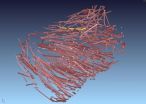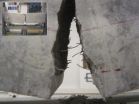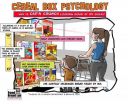(Press-News.org) Reinforcing concrete with steel bars is a very common practice in construction. The industrial engineer and researcher Aimar Orbe-Mateo (UPV/EHU-University of the Basque Country) has studied the possible use of a material that is normally used for other applications for these tasks: concrete reinforced with steel fibres.What the study shows is that this material has certain advantages over conventional reinforced concrete; among others, it is less prone to cracking, and it can be used for purposes like the manufacture of cylindrical holding tanks.
According to Aimar Orbe-Mateo, an engineer at the Faculty of Engineering in Bilbao, right from the start of the study it was clear that "it had to be something that had a practical application, not just any piece of research". Sothe team produced a material for research purposes and which had the potential for being used in construction: steel fibre reinforced self-compacting concrete (SFRSCC).
These are materials that are already being used in building but "they have other applications. Self-compacting concrete, for example, is used in prefabricated buildings. If this concrete is used in conventional building tasks, it is difficult to measure it out because it is very fluid, very runny. Yet its texture allows one to do away with the procedures that are used with conventional concrete (vibration, shovelling, etc.), because it moves and becomes compact on its own," pointed out Orbe.
Steel fibres are also used to reinforce glass, "but more than anything else, to manufacture secondary elements: paving of industrial estates, tunnels, sewage pipelines and such things," he added. These fibres are small, both in terms of length (50 mm) and diameter (1mm), with dimensions similar to those of an unbent paper clip."
From the lab to reality
Alongside the laboratory tests, the team also tested the use to which the material could in fact be put.For this purpose, a wall three metres high and six metres long was built and divided into 380 samples on which various tests were carried out, destructive as well as non-destructive ones, "to determine the structural capabilities of the steel fibres and, in general, the toughness of the wall," highlighted Orbe.
Since the toughness of the structure depends on the orientation and distribution of the fibres within the concrete (impossible to see with the naked eye), the research team resorted to a magnetic system.Firstly, a magnetic field was created inside the samples; then the changes that had taken place in the field were analysed.Two aspects were clarified: the axis towards which the fibres tended to orientate themselves, and how much fibre there was in each sample.According to this study, "the fibres orientated themselves in the direction we were interested in, thanks to the fluid nature of the self-compacting concrete," pointed out the researcher.Apart from these tests, the team carried out computer simulations on fluid dynamics."These simulations showed us that the orientation that the fibres are going to take can be predicted.That way we can detect the weak points and unsuitable concreting processes in advance," pointed out the researcher.
Other tests in the research showed that when compared with conventional concrete reinforcing barsthe steel fibres canmore effectivelycontrol the cracks that may open up when the concrete dries. "There are thousands of fibres distributed throughout the mortar that compact it continually," asserted the engineer.
Orbe believes that with these pieces of research, the material "has reached a level of maturity" and that it can contribute towards making certain construction work easier.Specifically, he is proposing that it be used for manufacturing cylindrical holding tanks for collecting water.Bearing in mind the capacity of the SFRSCC to control cracks better and the results of other studies undertaken by this research team,"the conclusion is thatit is more economical and more sustainable than the conventional structural design," asserted Orbe.
But using it (for the purposes put forward by the research team and for other ones) requires "building contractors to be aware of the advantages of this material".And it is difficult to persuade building contractors not to fit the traditional steel rods, that everything needs to have been mixed into the concrete, because that way it reinforces the, etc.At the same time, one reason for mistrust is the fact that when the concrete dries, it is not possible to see where the fibres are, whether they have been properly distributed or are facing in the right direction. Besides, stresses Orbe, "there are few examples of building work carried out using this system."
INFORMATION: END
Steel-fiber reinforced concrete for conventional construction work as well
2014-04-02
ELSE PRESS RELEASES FROM THIS DATE:
Research method integrates meditation, science
2014-04-02
PROVIDENCE, R.I. [Brown University] — Mindfulness is always personal and often spiritual, but the meditation experience does not have to be subjective. Advances in methodology are allowing researchers to integrate mindfulness experiences with brain imaging and neural signal data to form testable hypotheses about the science — and the reported mental health benefits — of the practice.
A team of Brown University researchers, led by junior Juan Santoyo, will present their research approach at 2:45 p.m on Saturday, April 5, 2014, at the 12th Annual International Scientific ...
Infants are sensitive to pleasant touch
2014-04-02
Infants show unique physiological and behavioral responses to pleasant touch, which may help to cement the bonds between child and parent and promote early social and physiological development, according to research published in Psychological Science, a journal of the Association for Psychological Science.
Previous studies with adults have shown that when the skin is stroked, a specific type of touch receptor is activated in response to a particular stroking velocity, leading to the sensation of "pleasant" touch. Cognitive neuroscientist Merle Fairhurst of the Max Planck ...
Key chocolate ingredients could help prevent obesity, diabetes
2014-04-02
Improved thinking. Decreased appetite. Lowered blood pressure. The potential health benefits of dark chocolate keep piling up, and scientists are now homing in on what ingredients in chocolate might help prevent obesity, as well as type-2 diabetes. They found that one particular type of antioxidant in cocoa prevented laboratory mice from gaining excess weight and lowered their blood sugar levels. The report appears in ACS' Journal of Agricultural & Food Chemistry.
Andrew P. Neilson and colleagues explain that cocoa, the basic ingredient of chocolate, is one of the most ...
First peanut genome sequenced
2014-04-02
Athens, Ga. – The International Peanut Genome Initiative—a group of multinational crop geneticists who have been working in tandem for the last several years—has successfully sequenced the peanut's genome.
Scott Jackson, director of the University of Georgia Center for Applied Genetic Technologies in the College of Agricultural and Environmental Sciences, serves as chair of the International Peanut Genome Initiative, or IPGI.
The new peanut genome sequence will be available to researchers and plant breeders across the globe to aid in the breeding of more productive ...
'3D' test could reduce reliance on animals for testing asthma and allergy medications
2014-04-02
To determine whether new medicines are safe and effective for humans, researchers must first test them in animals, which is costly and time-consuming, as well as ethically challenging. In a study published in ACS' journal Molecular Pharmaceutics, scientists report that they've developed a simple, "3D" laboratory method to test asthma and allergy medications that mimics what happens in the body, which could help reduce the need for animal testing.
Amir Ghaemmaghami and colleagues note that respiratory conditions, such as asthma and allergies, are becoming more common. ...
World's oldest weather report could revise Bronze Age chronology
2014-04-02
An inscription on a 3,500-year-old stone block from Egypt may be one of the world's oldest weather reports—and could provide new evidence about the chronology of events in the ancient Middle East.
A new translation of a 40-line inscription on the 6-foot-tall calcite block called the Tempest Stela describes rain, darkness and "the sky being in storm without cessation, louder than the cries of the masses."
Two scholars at the University of Chicago's Oriental Institute believe the unusual weather patterns described on the slab were the result of a massive volcano explosion ...
JCI Online ahead of print table of contents for April 1, 2014
2014-04-02
NOS1 expression predicts melanoma-dependent immune dysfunction
Individuals with cancer often exhibit dysfunctional immune signaling in response to interferon (IFN) stimulation. Furthermore, recent evidence indicates that pSTAT-1 levels, which are indicative of IFN responsiveness, in circulating immune cells are predictive of clinical outcome in melanoma patients. In this issue of the Journal of Clinical Investigation, Qiuzhen Liu and colleagues at Southern Medical University, Guangzhou, China determined that melanoma cells have differing capacity to dampen IFN responses ...
Scientists eager to participate in public discourse on environment
2014-04-02
A survey of more than 500 researchers indicates that scientists have the desire to get more involved in public discussion and policy decisions regarding environmental issues, but have concerns about how their efforts might be perceived.
"Scientists debate whether they have a role in advocacy," says Gerald Singh, a PhD student in the Institute for Resources, Environment and Sustainability at UBC, who conducted the survey with his colleagues. "Some feel they need to remain objective and can't engage. Others feel they have a duty to get involved so that decisions are made ...
Eyes in the cereal aisle -- how Cap'n Crunch's gaze is influencing your purchasing
2014-04-02
Director of Cornell's Food and Brand Lab Brian Wansink and post-doctoral lab researcher Aner Tal, are releasing a new study today published in the Journal of Environment and Behavior that discovered consumers are 16 percent more likely to trust a brand of cereal when the characters on the boxes on the supermarket shelves look them straight in the eye. Not surprisingly, the study also found that the gaze of characters on children's cereal boxes is at a downward, 9.6-degree angle, while characters on adult cereal boxes look almost straight ahead.
Wansink says:
"If you ...
Positive, negative thinkers' brains revealed
2014-04-02
EAST LANSING, Mich. --- The ability to stay positive when times get tough -- and, conversely, of being negative -- may be hardwired in the brain, finds new research led by a Michigan State University psychologist.
The study, which appears in the Journal of Abnormal Psychology, is the first to provide biological evidence validating the idea that there are, in fact, positive and negative people in the world.
"It's the first time we've been able to find a brain marker that really distinguishes negative thinkers from positive thinkers," said Jason Moser, lead investigator ...




